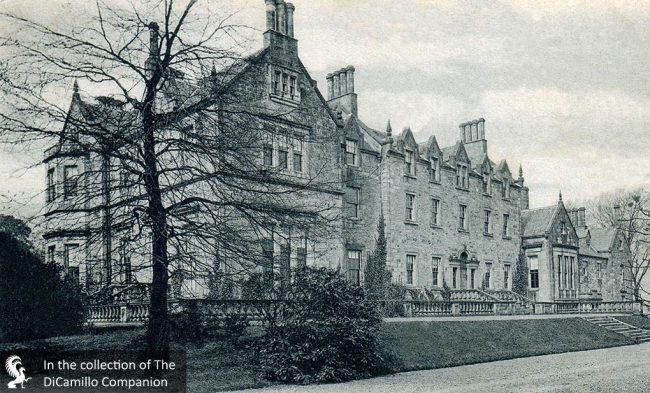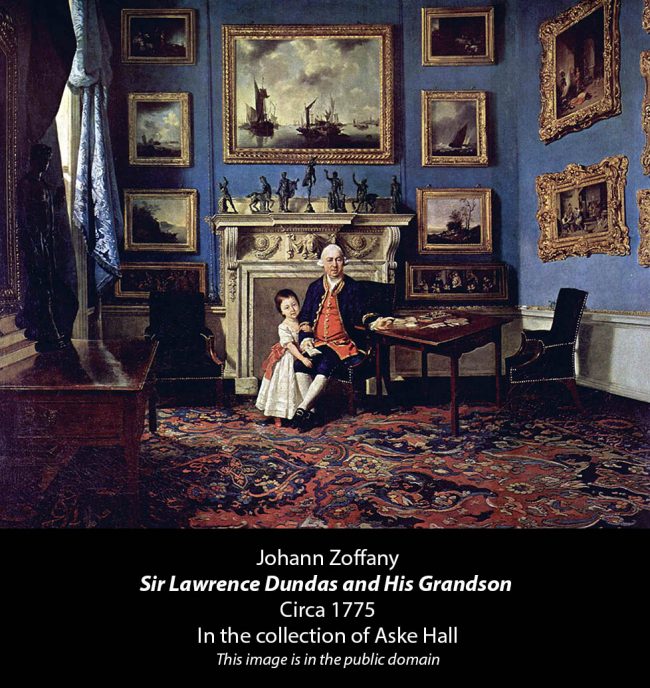
The house from a 1905 postcard

In this famous conversation piece, Sir Lawrence Dundas is shown in one of the Robert Adam-designed rooms of his London townhouse, 19 Arlington Street. Purchased by Sir Lawrence in 1763 for £15,000, 19 Arlington remained the Dundas family’s London home until it was demolished in 1936 and replaced by an apartment building.
Earlier Houses: There was a 16th century tower house that was incorporated into the 18th century house.
House & Family History: Sir Lawrence Dundas, who rebuilt Kerse House in the 18th century, had a spectacularly successful career. The second son of Thomas Dundas, a draper from Perthshire, Lawrence began his professional life as a modestly successful wine merchant. He hit the big time in the 1750s, when he was appointed commissary general to the forces during the Seven Years' War. This position, in which he supplied goods to the British Army, enabled Lawrence to amass a great fortune, which he used to become a successful banker and Whig politician. Made a baronet in 1762, Sir Lawrence used his great wealth to buy houses and estates in England, Scotland, and Ireland. A member of the Society of Dilettanti, and a man of great taste, he formed large and important art collections at his houses and commissioned furniture and fittings from the finest makers of the day, including Thomas Chippendale, John Cobb, and William Vile (see “Images” section for Zoffany painting of Sir Lawrence and his grandson in his London townhouse). At his death in 1781, Sir Lawrence left his son an immense fortune of £900,000 (over £1 billion in 2019 inflation-adjusted values using the labour value commodity index). Sir Lawrence is buried in the Dundas Mausoleum at Falkirk Old Parish Church. The son who inherited this great wealth was Thomas (1741-1820), who was educated at Eton and the University of St. Andrews. Between 1763 and 1768 Thomas was MP for Richmond, Yorkshire, and later (1768-94) for Stirlingshire. Upon the death of his father Thomas inherited his father's baronetcy and all his estates, including the Kerse Estate, through which his father had built the Forth and Clyde Canal. In his position as governor of the Forth and Clyde Canal Company Sir Thomas, as he became, commissioned William Symington (1763-1831) to build a tug for his canal, which became the world's first steam-powered boat. Named the "Charlotte Dundas" (after Sir Thomas's daughter), the tug had its first sailing on the canal in Glasgow on January 4, 1803, with Lord Dundas (he was by then a peer) onboard. The boat proved capable of towing heavy barges, which fueled fear by its opponents that it would damage the canal banks; this sadly resulted in the project being abandoned. The "Charlotte Dundas" was left in a backwater of the canal at Bainsford, until it was broken up in 1861. The development of steamboats was continued by others, including Robert Fulton in the USA and Henry Bell in Scotland. In 1794 Sir Thomas was created Baron Dundas of Aske; his son and successor, Lawrence, was created 1st Earl of Zetland in 1838; his grandson, another Lawrence, became the 1st Marquess of Zetland in 1892. Kerse House was demolished circa 1958; the Dundas family is today seated at Aske Hall in Yorkshire.
Architect: John Tait
Date: 1830-31Architect: John Adam
Date: 1763
Title: Biographical Dictionary of British Architects, 1600-1840, A - SOFTBACK
Author: Colvin, Howard
Year Published: 1995
Reference: pgs. 51, 946
Publisher: New Haven: Yale University Press
ISBN: 0300072074
Book Type: Softback
House Listed: Demolished
Park Listed: Destroyed
Past Seat / Home of: Sir Lawrence Dundas, 1st Bt., until 1781; Sir Thomas Dundas, 1st Baron Dundas and 2nd Bt., 1781-1820; Lawrence Dundas, 1st Earl of Zetland and 2nd Baron Dundas, 1820-39; Thomas Dundas, 2nd Earl of Zetland, 1839-73; Lawrence Dundas, 1st Marquess of Zetland and 3rd Earl of Zetland, 1873-1929.
Current Ownership Type: Demolished
Primary Current Ownership Use: Demolished
House Open to Public: No
Historic Houses Member: No